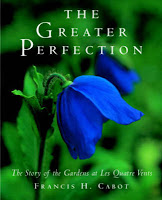 |
Francis H. Cabot
(19251-2011) |
Last November my wife read the
NY Times's obituary of
Francis H. Cabot, described as "a financier and self-taught horticulturalist who created two of the most celebrated gardens in North America."
I suppose that she was attracted by the article's title, which included the clause,
created notable gardens. The second of those gardens was
les jardins de Quatre Vents, which we visited eleven days ago, on Saturday, July 21. In the course of our guided tour through Mr. Cabot's "gardens of the four winds" (conducted in French, with my wife's questions kindly answered in English), we walked around the house in which Mr. Cabot had lived, and died on November 19:
The map appears on the inside front cover and flyleaf of Cabot's 2001 book,
The Greater Perfection: The Story of the Gardens at Les Quatre Vents, which was of course mentioned in the obituary. And there's another (interactive) version of the map
here.
I was delighted, when I requested the book from a UNC library, to learn that it was in the
art library's collection.
The publisher's website describes the book, but I like the following description from
anobii, a website devoted to "finding better books":
The story behind the creation of one of the world's most breathtaking public gardens. Les Quatre Vents in Charlevoix County, Quebec, has been acclaimed as the most aesthetically satisfying and horticulturally exciting landscape experience in North America. The garden seamlessly combines elements from the best gardening traditions with the original and the unexpected into a splendid composition that is nevertheless perfectly compatible with its natural surroundings. The Greater Perfection illustrates the delights, diversions, and surprises that await a visitor to these extraordinary gardens. The book chronicles the family origins of Les Quatre Vents as well as the story of its expansion during the last twenty-five years. Author Francis Cabot's account of the challenges of developing and enlarging Les Quatre Vents reveals the fascinating process behind the creation of a world-class garden that has become a mecca for horticultural enthusiasts from around the globe. Featuring photographs by five of today's leading garden photographers, this is one of the most beautiful books on gardens to appear in years. 382 color photographs, 25 black-and-white photographs.
A dedicatory quotation demonstrates that Mr. Cabot agreed with Voltaire's Candide, that it's necessary to cultivate our garden
2.
The reason we went to La Malbaie, Quebec at all was to visit les
Quatre Vents. That is, our day trip to be among the
baleins and the
bohemians was but an extra.
Because les Quatre Vents is open for tours only two weekends in July, my wife made reservations for us within a week or two of reading the obituary. We could combine the trip with our visit to the Killington Music Festival in Vermont to see our son, who, unfortunately, couldn't get away from the festival to join us in La Malbaie.
Here are a few of my own modest photographs, taken with my wife's Nikon Coolpix P100, before its battery expired about half-way through the tour (I had failed to remember its also expiring quickly in Bulgaria last year or to bring along my P300 as well; we weren't carrying our Droids in Canada). Shown in chronological order:
 |
| The group ahead of us assembles |
 |
| And listens tautly |
 |
Cabot's house
(picture an opening to the right, not in picture) |
 |
The opening imagined in the previous photograph,
featuring the long, stage-managed vista
(what I call an allée) that Cabot seemed to relish |
 |
| Cabot's house on left, La Malbaie to the south beyond |
 |
| A shallow, ground-level pool favored by Cabot |
.jpg) |
| Our guide (image upside-down) |
 |
Delphiniums, which we saw in great
abundance at Les Quatre Vents
(my wife was amazed at how tall they were) |
 |
| Another allée |
 |
A silhouette, the book tells us, of "Phoebe and her dog,"
"an interesting way of lending excitement and
interest to a terminal focal point" [–p. 130]
(placed at the approximately east end of a long
allée, where, somewhere near the middle,
I stood for the zoomed photograph) |
 |
Sculpture opposite Phoebe, out in the pasture,
perhaps 200 meters away
(extreme zoom, not cropped) |
There was so much more my camera wasn't up to capturing, especially
le pigeonnier,
the performing frogs (whose recorded performance plays when a tourist trips an infrared signal), and the authentic
Japanese tea house.
But perhaps you can borrow or purchase the book, visit
the garden's website, obtain
the DVD of Cabot's presentation on the development of the gardens (we brought one home; it contains a French version and an English version)—or travel to
La Malbaie some future July!
_______________
- Francis H. Cabot was born on August 6, a little over two months before Prime Minister Margaret Thatcher (born Roberts on October 13, 1925).
- Pangloss disait quelquefois à Candide: "Tous les événements sont enchaînés dans le meilleur des mondes possibles; car enfin, si vous n’aviez pas été chassé d’un beau château à grands coups de pied dans le derrière pour l’amour de Mlle Cunégonde, si vous n’aviez pas été mis à l’Inquisition, si vous n’aviez pas couru l’Amérique à pied, si vous n’aviez pas donné un bon coup d’épée au baron, si vous n’aviez pas perdu tous vos moutons du bon pays d’Eldorado, vous ne mangeriez pas ici des cédrats confits et des pistaches."
"Cela est bien dit," répondit Candide, "mais il faut cultiver notre jardin.”
[—Voltaire, Candide]

















.jpg)










.jpg)






























.jpg)
.jpg)



.jpg)
